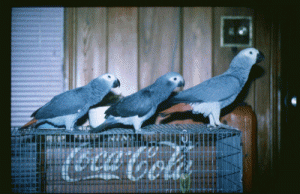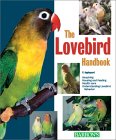African Grey Parrots

The bird in the middle is a Timneh. Left bird is smaller Congo, far right bird is large Congo. (Photo reprinted with permission from Jean "The African Queen" Pattison)
Origin: African continent (various areas depending on subspecies)
Species: Psittacus erithacus erithacus (Congo) and P. e. timneh (Timneh)
African grey parrots have the reputation as being the best talkers of the parrot kingdom. They have an uncanny ability to not only mimic speech, but mimic it in a voice that sounds quite human. They also imitate sounds with incredible accuracy, from dripping faucets to construction equipment. Be careful about uttering any words you don’t want your bird to learn, since they seem to have a knack for learning just what you don’t want them to learn!
Because of their exceptional intelligence, African greys require an extremely stimulating environment. They can easily become bored and birds that are left cagebound can develop serious behavioral problems, such as destructive feather mutilation. I have seen many a plucked grey. In cases of feather picking, an avian vet should take blood samples and test for bacterial infection or other physical factors first.
Greys have some reputation for clumsiness, but this is generally not a problem if the bird has a proper wing trim. It is extremely important not to overclip the wings. In cases where this has been done, birds can hit the ground too hard and split the skin at the keel bone. If this happens, the bird should be given immediate vet attention.
Do not buy an African grey just because you want a bird that talks. Not all greys talk. Not all parrots known for talking will talk. It is a very bad idea to get a bird only because you want a pet that talks as you could end up disappointed and the bird could end up neglected.
Caging: As large a cage as possible with plenty of horizontal bars to facilitate climbing. Plenty of perches and toys. Toys should be rotated regularly to prevent boredom. It is a nice idea to set the tv or some music on a timer to go on and off during the day to keep the bird amused while you are at work. The timer gives them adequate quiet time for naps.
Diet: medium or large hookbill seed, medium pellets, fresh vegetables, some fruit, palm nuts (native food), corn, sprouts, and grains. Give a varied diet to keep the bird interested and also to avoid food “phobias”. They need a little more calcium than some parrot species, but beware of too much calcium (can cause seizures).
Health: Generally very robust birds, but can nervous when changes are made to the environment. They are prone to feather plucking problems if frustrated and left cagebound for long periods of time. This can develop into a serious problem in some cases. Anyone interested in an African grey should be very clear on the fact that they do need a stimulating environment. People with serious time issues would be better off with another species of bird.
Noise: Not particularly noisy. Once they get talking, they can really go on for quiet a while, but it is usually so amusing you don’t want them to stop. Alarm sound is a series of sharp, shrill shrieks.
Sleep: At least 10 hours of darkness and quiet. A tv in the room does not equal good sleep.
Sexual behavior: Both males and females will sometimes regurgitate for their human. They are not known to be highly aggressive during hormonal periods, but there will be some change in behavior when they become sexually mature. Many birds become more protective of the cage and wary of new things. It is a good idea to expose the bird to new things on a regular basis early on and throughout its adulthood so it learns to adjust.
Breeding: Best for experienced breeders.









